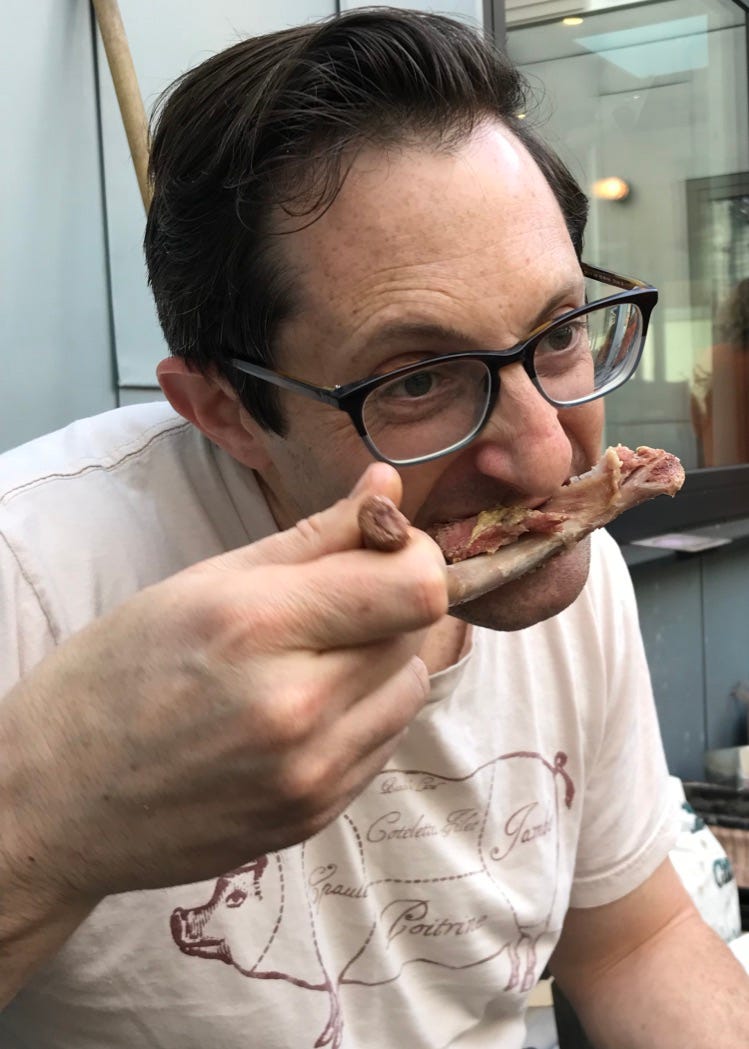Eating like you mean it
I spend a lot of time watching people eating. You get in the habit if you run a restaurant. Sometimes, I don’t just watch people eat, I take pictures of them doing so too.

Eating is one of the few basic activities of daily life in which we engage in public. I love how naked it is.

With luck, I get photos of unaffected joy. These aren’t photos of peak experience. They’re quotidian, as joy should be. It helps if there’s an animal bone involved.

In case you haven’t realized, this is a substitute for a real column this week. I started one and realized it was going to take two weeks to write (and I’ve been a wee bit under the gun). I’m sorry. But I wanted to get something out on Wednesday, so here’s a little photo collection instead.

Incidentally, if you’d like me to take some photos of you eating, just let me know! I’d be delighted to do so.
A brief story about an eater whose photo I didn’t get to take -
I was riding the 5 from Union Square to midtown yesterday morning around 11am. There was a gentleman standing near the end of the car, in a black parka with a pinstripe shirt beneath. He looked like I imagine Ron Glass would look if Ron Glass were with us still, a few years older, a few years more weary. Deep set eyes and a nose that belonged on Mount Rushmore, the kind of nose it took a year to sculpt. As we pulled out of Union, he took a sandwich out of a Dunkin Donuts bag. The sandwich consisted of a slice of whole wheat bread folded around a flour tortilla, and he proceeded to eat it slowly all the way uptown.
He didn’t eat so much as commune with this sandwich. His eyes were empty, his body was slack. Nothing moved except the muscles in his jaw, rolling like breakers beneath his skin. I could taste the sandwich as I watched him, the elastic toughness of the tortilla within the pillow of dry bread, the salt and chew and the wisp of oil, the wheaten sweetness of the dough. I’ve rarely seen someone so consumed by the act of eating, rarely seen the act bring such serenity.
This gentleman and his tortilla sandwich may as well have been the patron saint of subway diners. Every dishwasher who’s cradled a cup of thick white coffee on the train from one basement to the next, every courier who’s wolfed a folded slice with elbows on knees, every straphanger who’s delicately kept an egg-and-cheese and a business suit apart. Everyone I see eating on the subway seems to do so with this combination of need and desire, utter absorption and genuine pleasure.
On canteens, a piece from across the pond that might be having its moment in the sun. Canteens were a feature of my childhood in a commonwealth country, but I don’t think I ever heard either word used here before Google started building them. Instead there are cafeterias and dining halls, words that have always seemed to me to emphasize how grudgingly these facilities were provided, as opposed to the rosily democratic spirit Rebecca May Johnson ascribes to their British equivalent. However tinted Ms. Johnson’s glasses might be, I see a similarity between Google’s canteens and the rash of food halls in America. To someone raised in Singapore, these look like nothing so much as attempts to recreate hawker centres in New York, but because they are conceived and built for profit rather than because the idea is really part of the cultural fabric, they too are exploitative at the core.
And not at all food related, but the best thing I read this month was this piece on cathedral building. If you’ve even thought about carrying out a renovation or a building project, it’s well worth reading, but what especially resonated was this paragraph, which may as well have been written about restaurants - like cathedrals, they accrete, and are never finished:
Guy Nordenson, a New York structural engineer and teacher who has worked on a number of megaprojects (including, briefly, St. John the Divine), argues that a megaproject succeeds because it resonates “in a powerful, fundamental way.” Contemporary megaprojects are fragile because they are capitalistic, without a solid foundation of social justice or labor relations: “Does anyone ask an iron worker his opinion about the design of something like Hudson Yards? Hudson Yards is executed directly from the dictates of one person who runs the development company that has overseen it, and to whom the city and the state had abdicated all social responsibility.” The Apollo Program, the Brooklyn Bridge, the Chunnel – these were successful, posits Nordenson, “because the idea was compelling.” Nordenson sees the essence of a successful project as bound up with an idea John Ruskin described when he talked about gothic architecture: Every participant – from the bishop to the artisan carving gargoyles – has a shared ownership of the project’s outcome. That is, a project succeeds when there is an alignment between the people who design buildings and the people who build and use them…
Thank you for reading let them eat cake, a weekly newsletter about food systems and food. And as always, a super-special thank you to my pre-release readers, Jen Thompson and Diana Kudayarova. And thank you too to everyone who let me publish a photo of them this week - Diana, Adam, Chloe, and Sequoia the dachshund.
If you’ve enjoyed the stories so far, please consider sending a link or an issue along to someone you know who might find this interesting, or consider posting something about this on social media. There’s nothing like word of mouth.
best,
tw
p.s. I’d love to buy you a coffee. Drop me a line!


